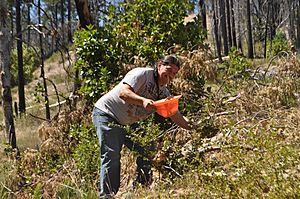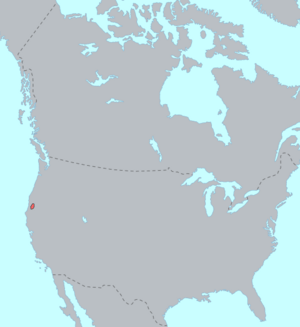Karuk facts for kids

Karuk leader Ron Reed collecting gooseberries (2014)
|
|
| Total population | |
|---|---|
| 2010 census: 6,115 alone and in combination | |
| Regions with significant populations | |
| California (Yreka, Happy Camp, Orleans), Oregon | |
| Languages | |
| English, Karuk | |
| Religion | |
| Christianity, other | |
| Related ethnic groups | |
| Yurok |
The Karuk people are an Indigenous group who have lived in California for a very long time. The Karuk Tribe is one of the largest tribes in California. Some Karuk people are also part of two other federally recognized tribes: the Cher-Ae Heights Indian Community of the Trinidad Rancheria and the Quartz Valley Indian Community.
The town of Happy Camp, California, is right in the middle of the Karuk Tribe's traditional lands. These lands stretch along the Klamath River from Bluff Creek (near Orleans in Humboldt County) through Siskiyou County and into Southern Oregon.
Contents
What Does "Karuk" Mean?
The name "Karuk" (sometimes spelled "Karok") means "upriver people" or "upstream people." In the Tolowa language, they are called Chum-ne.
The Karuk Language
The Karuk people speak the Karuk language. This language is unique because it's a "language isolate," meaning it's not closely related to any other known language. The Karuk Tribe is working hard to keep their language alive through active programs.
How Many Karuk People Are There?
It's hard to know exactly how many Native people lived in California before Europeans arrived. One expert, Alfred L. Kroeber, thought there were about 1,500 Karuk people in 1770. Another expert, Sherburne F. Cook, estimated around 2,000 to 2,700. By 1910, Kroeber reported that about 800 Karuk people remained.
According to the 2010 census, there were 6,115 people who identified as Karuk.
Karuk Culture and Traditions
For a very long time, the Karuk people have lived in villages along the Klamath River. They continue many of their cultural traditions today, such as hunting, gathering, fishing, making baskets, and performing special dances. The Karuk were the only tribe in California known to grow their own tobacco plants.
Their important ceremonies, like the Brush Dance, Jump Dance, and Pikyavish, can last for several days. These ceremonies are performed to heal people and "fix the world." They also pray for plenty of acorns, deer, and salmon, and to bring back good feelings among people and good luck for individuals.
In the 1870s, a researcher named Stephen Powers visited Native groups in Northern California. He wrote about the Karuk people, noting that they were one of three groups living on the Klamath River (the others being the Yurok and Modoc). He also mentioned that the Karuk had no stories of moving to the region; instead, their legends told of Creation and a Great Flood happening right there on the Klamath.
Powers also observed some interesting things about Karuk life:
- The Karuk were very democratic, meaning they believed in equality. Each village had a headman or captain.
- They used bows and arrows for fighting. In close combat, they would use jagged stones.
- There were two types of traditional healers: "root doctors" and "barking doctors." The barking doctor, often a woman, would diagnose problems by "barking" at the patient. Then, the root doctor would use plants and medicines to treat the illness.
- A very important event was the "Dance of Propitiation," also called "working the earth." This dance was held to ask the spirits of the earth and forest to prevent disasters like landslides, forest fires, earthquakes, and droughts.
The Karuk people had a deep understanding of plants and animals. They used them not just for food, but also for tools, clothing, and medicines. For example, they grew tobacco and used a plant called Coastal woodfern to help prepare eels for eating.
Karuk People in Film
- Pikyáv (to fix it) (2008): A documentary film about the Karuk people and their traditions.
Notable Karuk People
- Rob Cabitto: An author.
- Naomi Lang: A famous figure skater. She was a five-time US Champion in ice dancing from 1999 to 2003. In 2002, she became the first Native American woman to compete in the Winter Olympics. Her great-great-grandmother was a full-blooded Karuk.
- Buck Martinez: A former professional baseball player and now a sports broadcaster.
- Anthony Earl Numkena (Hopi/Karuk): An actor who appeared in films and TV shows in the 1950s. His grandmother was three-quarters Karuk.
- Jetty Rae: A musician whose grandmother was a full-blooded Karuk.
See also
 In Spanish: Karok para niños
In Spanish: Karok para niños


